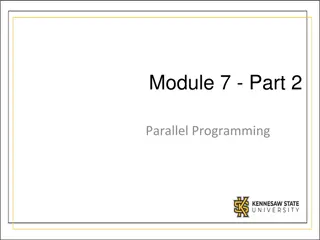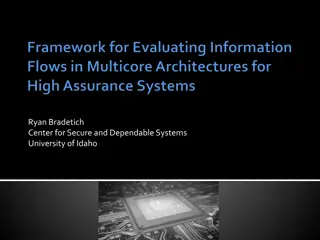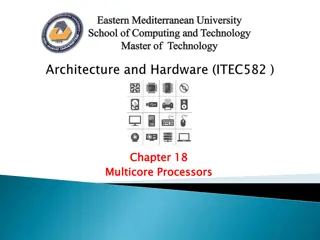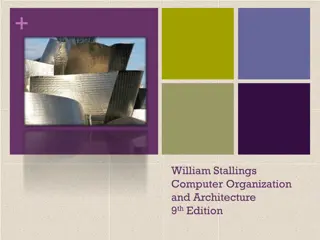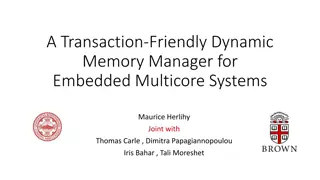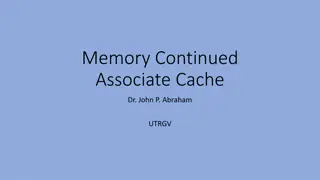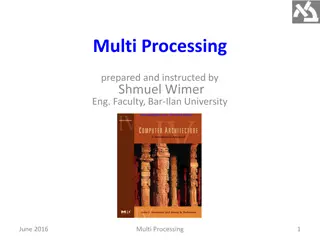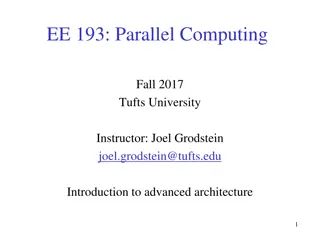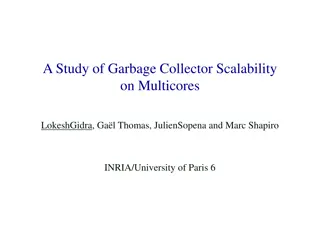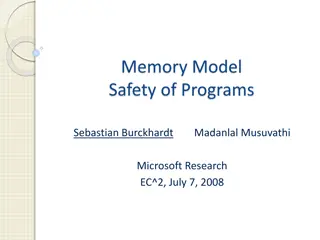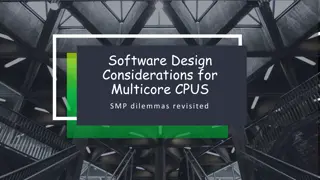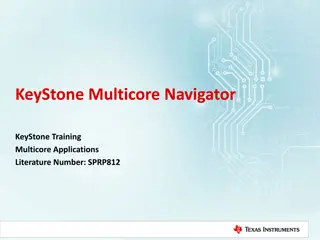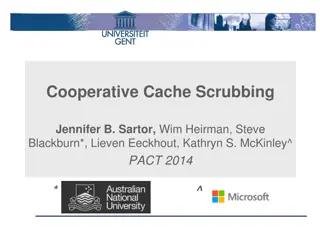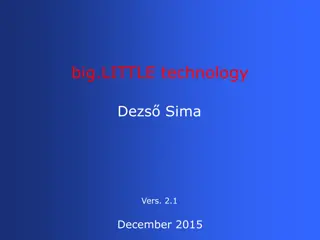
Multicore CPU Designs: Rethinking Operating System Strategies
Discover the evolution of multicore CPUs from mainframes to personal computers, the impact on traditional speedup trends, challenges in general-purpose multicore utilization, and research issues in multicore systems. Explore concepts like memory sharing styles and communication frameworks in a multicore world.
Download Presentation

Please find below an Image/Link to download the presentation.
The content on the website is provided AS IS for your information and personal use only. It may not be sold, licensed, or shared on other websites without obtaining consent from the author. If you encounter any issues during the download, it is possible that the publisher has removed the file from their server.
You are allowed to download the files provided on this website for personal or commercial use, subject to the condition that they are used lawfully. All files are the property of their respective owners.
The content on the website is provided AS IS for your information and personal use only. It may not be sold, licensed, or shared on other websites without obtaining consent from the author.
E N D
Presentation Transcript
RETHINKING OPERATING SYSTEM DESIGNS FOR A MULTICORE WORLD Ken Birman Based heavily on a slide set by Colin Ponce
THE RISE OF MULTICORE CPUS Multicore computer: A computer with more than one CPU. 1960-1990: Multicore existed in mainframes and supercomputers. 1990's: Introduction of commodity multicore servers. 2000's: Multicores placed on personal computers. Soon: Everywhere except embedded systems? But switched on and off based on need: each active core burns power Debated: Will they be specialized cores (like GPUs, NetFPGA) or general purpose cores? Or perhaps both?
MULTICORE IS INESCAPABLE! Clearly, traditional speedup could not continue beyond 2005. or s0 But we do need speedup or technology progress comes to a halt
THE END OF THE GENERAL-PURPOSE UNIPROCESSOR
MULTICORE RESEARCH ISSUES The machines have become common, but in fact are mostly useful in one specific situation Cloud computing virtualization benefits hugely from multicore We end up with multiple VMs running side by side, maybe sharing read-only code pages (VM hardware ideally understands that these are never dirty and won t suffer from false sharing). Each VM uses the same cores each time it becomes active (hence good affinity) Offers a very good price/performance tradeoff to Google, Amazon But general purpose exploitation of multicore has been hard So the machine on your desk might have 12 cores, yet rarely uses 2
PUZZLE: IS MULTICORE USEFUL? To host multiple VMs concurrently, for sure. Any modern multitenant data center exploits this feature VMs share nothing , hence ideal for use with multicore servers But for general purpose programming, far less evident We see this in mini-project 1: Leveraging multicore parallelism for speedup is very difficult. Slow-down is not uncommon! Problem: any form of sharing seems to be an obstacle to speed Even compilers have serious difficulty with modern hardware models.
BASIC CONCEPTS Memory Sharing Styles: Uniform Memory Access (UMA) Non-Uniform Memory Access (NUMA) No Remote Memory Memory Access (NORMA) Cache Coherence Many models: barrier, sequential, causal Inter-Process (and inter-core) Communication Shared Memory: At granularity of cache line Message Passing: Implemented by OS but shapes what the h/w sees
WRITING PARALLEL PROGRAMS: AMDAHL'S LAW N: Number of processors B: Unavoidably sequential portion T(n): Runtime with N processors Speedup:
EXPLOITING PARALLEL PROCESSORS Experiment by Boyd-Wickizer et. al. on machine with four quad-core AMD Operton chips running Linux 2.6.25. n threads running on n cores: i d = g e t t h r e a d i d ( ) ; f = c r e a t e f i l e ( i d ) ; wh i l e ( True ) { f 2 = dup ( f ) ; c l o s e ( f 2 ) ; } Looks embarassingly parallel so it should scale well, right? Boyd-Wickizer et. al., Corey: An Operating System for Many Cores"
LINUX IS NOT GOOD AT MULTICORE! Application developer could provide the OS with hints: Parallelization opportunities Which data to share Which messages to pass Where to place data in memory Which cores should handle a given thread Right now, this doesn t happen, except for pin thread to core Should hints be architecture specific? What about GPU?
HINTS IN ACTION Example: OpenMP (Open MultiProcessing) Coded in C++ 11 But the pragmas tell the compiler about intent Compiler can then optimize the code for parallelism / speed
IS IT ONE MACHINE? OR MANY? Modern machines often have several identical cores But even with identical cores it isn t obvious how to think about these machines Problem: Location of data very much shapes performance of computation on that data Here is a simple one-chip AMD 4-core design
EVEN WITH IDENTICAL CORES With multiple AMD chips in a multisocket CPU board, looks more and more like a distributed computer cluster! This illustrates a 16-core system, but looks just like a quad-computer system with each chip being a 4-core AMD processor
AMD 64-CORE CHIP AMD keeps pushing it to larger and larger scale Like a cluster on a chip
AMD 256-CORE CHIP Will it ever end? Real puzzle: how to harness all the cores
CORE DIVERSITY More and more vendors are exploring specialized cores GPU cores for high speed graphics NetFPGA: devices that can process video streams or other streams of data on the network at optical line speeds Computational geometry cores for manipulating complex objects Scientific computing accelerators that offer special functions like DFFTs via hardware support: you load the data, the chip does the operation, and then the outcome is available on the other side Some of these can support complex programs that run on the special processor, but use its own domain-specific programming style
TODAYS PAPERS: TORNADO Context: Need to understand the state of play in late 1990 s: Ten years prior, memory was fast relative to the CPU. During the 90's, CPU speeds improved over 5x as quickly as memory speeds. Over the course of the 90's, communication became a bottleneck. 1990 was prior to the full multicore revolution. But even in 1990 these issues were exacerbated in multicore systems. Tornado developers saw this as a primary issue Tornado: Maximizing Locality and Concurrency in a Shared Memory Multiprocessor Operating System" Ben Gamsa, Orran Krieger, Jonathan Appavoo, Michael Stumm OSDI 1999
INITIAL OBSERVATIONS The hardware makes cross-core interactions transparent, but in fact the cost penalty is often high Locking by threads is cheap if on same core, expensive cross-core Memory sharing looks free, but in reality cache-line migration can be very costly (true sharing with writes is the big issue) L2 cache will be cold if a thread is paused, then resumes on a different core than where it ran previously So Tornado tries to minimize these costly overheads
TORNADO Develops data structures and algorithms to minimize contention and cross-core communication. Intended for use with multicore servers. These optimizations are all achieved through replication and partitioning. Clustered Objects Protected Procedure Calls New locking strategy
TORNADO: CLUSTERED OBJECTS OS treats memory in an object-oriented manner. Clustered objects are a form of object virtualization: the illusion of a single object, but actually composed of individual components spread across the cores called representatives. One option is to simply replicate an object so that each core has a local copy, but can also partition functionality across representatives. Exactly how the representatives function is up to the developer. Representative functionality can even be changed dynamically.
TORNADO: PROTECTED PROCEDURE CALLS Primary use case: To support parallel client-server interactions. Idea is similar to that of clustered objects. Calls pass from a client task to a server task without leaving that core. Benefits from affinity: hardware resources accessed by the collection of threads can live local to the core In effect, the OS is structured in a way that matches what the hardware is already good at doing. By spreading server representatives over multiple cores, we get parallel speedup without cross-core contention delays
TORNADO: LOCKING Locks are kept internal to an object, limiting the scope of the lock to reduce cross-core contention. Locks can be partitioned by representative, allowing for optimizations involving mixed coarse and fine-grained uses. For intended use (Apache web server), very good match to need, although seems a bit peculiar and not very general
TEN YEARS PASSED Pollack s Rule: Thousand Core Chips: A Technology Perspective. Shekhar Borkar Pollack's Rule: Performance to the square root of the increase in circuit complexity. This contrasts with power consumption power consumption increase, which is roughly linearly proportional to the increase in complexity Performance increase is roughly proportional Implication: Many small cores instead of a few large cores.
BARRELFISH A completely new OS, built from scratch that Views multicore machines as networked, distributed systems. No inter-core communication except through message-passing. Core OS seeks to be as hardware-neutral as possible, with per- architecture adaptors treated much like device drivers. Replicates entire application state across cores: everything is local. In effect, Barrelfish choses not to use features of the chip that might be very slow. The Multikernel: A new OS architecture for scalable multicore systems. Andrew Baumann, Paul Barham, Pierre-Evariste Dagand, Tim Harris, Rebecca Isaacs, Simon Peter, Timothy Roscoe, Adrian Schaupbach, Akhilesh Singhania. SOSP 2009
THE WAY OF BARRELFISH Presumes that in fact, cores will be increasingly diverse A small data center on a chip, with specialized computers that play roles on behalf of general computers And also assumes the goal is really research Not clear that Barrelfish intends to be a real OS people will use More of a prototype to explore architecture choices and impact How fast can we make a multicomputer run ?
THE WAY OF BARRELFISH so, Barrelfish Starts with a view much like that of a virtual computing system Lots of completely distinct VMs. Obvious fit for multicore But then offers a more integrated set of OS features So we can actually treat the Barrelfish as a single machine And these center on ultrafast communication across cores Not shared memory, but messages passed over channels
BARRELFISH MESSAGE PASSING This is the only way for separate cores to communicate. Advantages: Cache coherence protocols look like message passing anyways, just harder to reason about. Eases asynchronous application development. Enables rigorous, theoretical reasoning about communication through tools like -calculus.
HOW IT WORKS They design a highly asynchronous message-queue protocol We ll see it again in a few weeks when we discuss RDMA The Barrelfish version is circular Basically Wait for a slot in the circular queue to some other processor Drop your message into that slot, and done (no cross-core lock used) Request/reply: You include a synchronization token, and reply will eventually turn up, and wake up your thread
THE MULTIKERNEL Operating system state (and potentially application state) is automatically replicated across cores as necessary. OS state, in reality, may be a bit different from core to core depending on needs, but that is behind the scenes. Reduces load on system interconnect and contention for memory. Allows us to specialize data structures on a core to its needs. Makes the system robust to architecture changes, failures, etc. Claim: Enables Barrelfish to leverage distributed systems research (like Isis2 , although this has never been tried).
ATTEMPT TO BE HARDWARE NEUTRAL Separate the OS as much as possible from the hardware. Only two aspects of the OS deal with specific architectures: Interface to hardware Message transport mechanisms (needed for GPUs) Advantages: Facilitates adapting an OS to new hardware: device driver . Allows easy and dynamic hardware- and situation-dependent message passing optimizations. Limitation: Treats specialized processors like general purpose ones Future world of NetFPGA devices on the wire would be problematic
SUMMARY Multicore computers are here! They work really well in multitenant data centers (Amazon) But less well for general purpose computing Our standard style of coding may be the real culprit Seems like pipelines of asynchronous tasks are a better fit to the properties of the hardware, but many existing OS features are completely agnostic and allow any desired style of coding, including styles that will be very inefficient

